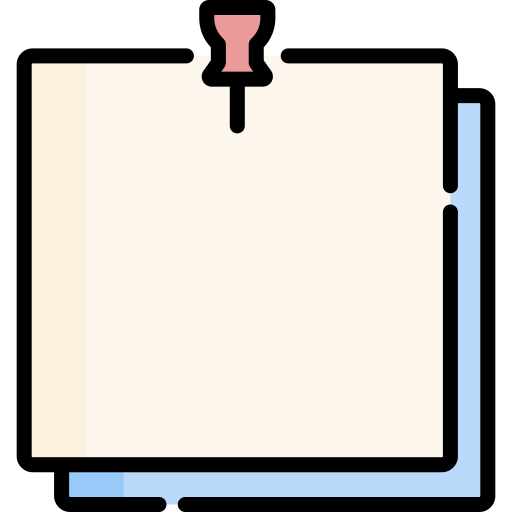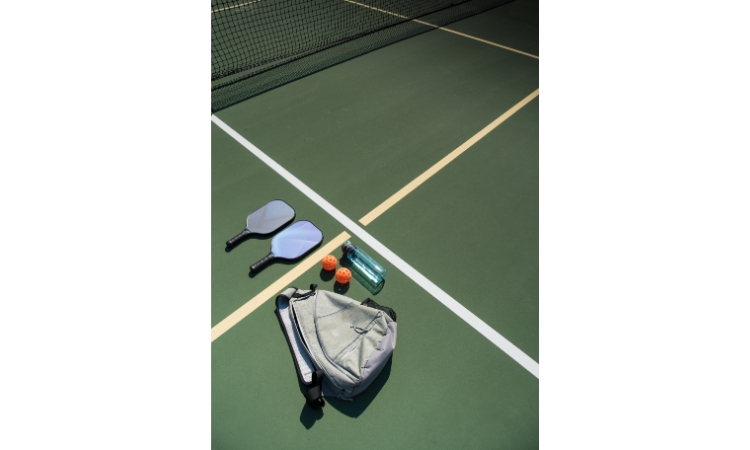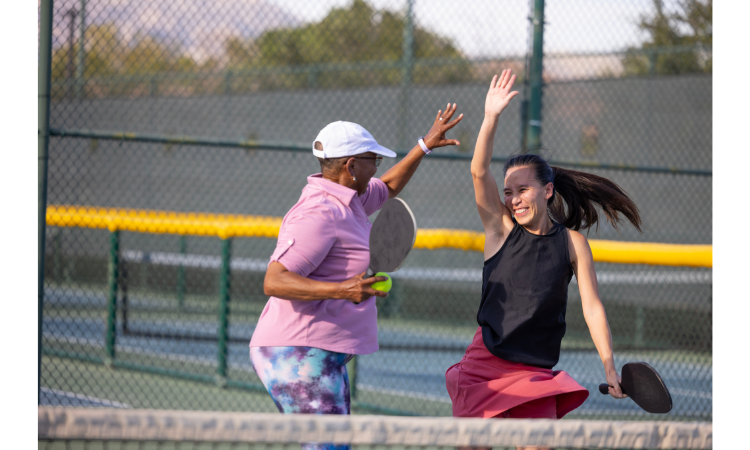Hey, new and seasoned picklers, did you know there is a set of hidden pickleball etiquette rules?
I’m sure you probably know some of them. But a few on this list may still surprise you. Before you go out to a public court for pickleball open play, read through this guide to participating in open play using hidden pickleball etiquette so you’re aware of the social norms surrounding this great, inclusive sport.
What is Pickleball Open Play?
There are many times when your fellow picklers’ schedules don’t align with yours. It can be tough to set a regular play time, much more adhere to it. And for newcomers to the sport—you may not even know that many people play pickleball.
Well, the good news is, you can get your pickleball fix even if you don’t have a scheduled game lined up. It’s called pickleball open play. You just have to muster up the courage to put yourself out there, meet new people, and join a game.
Open-play pickleball is when everyone of all pickleball skill levels can play at a public court or a pickleball facility. Most pickleball facilities have a scheduled block of time where you can pay a drop-in fee to play against anyone who’s at the courts. At the public courts, open play is pretty much all day, every day, as long as there are people there.
However the rules for open play differ slightly across different locations (more on this later), and understanding pickleball is crucial. Heaven forbid you show up and play only to offend someone out of ignorance.
Don’t worry, picklers are typically a welcoming, inclusive group.
But, just to be safe, familiarize yourself with the hidden pickleball etiquette rules so you can confidently participate in open play and help others do the same.
What Are the Rules to Open Play in Pickleball?
To participate in pickleball open play on outside public courts, let’s discuss some of the pickleball court rule signs you might see on the fence and what they mean.
1. Courts Are for Pickleball Use Only.
This pickleball court rule may seem like an obvious one, but you’d be surprised at how many people use public pickleball courts for other sports like soccer or kickball.
Playing other sports on a pickleball court can cause damage to the net and the court surface—if participants are not wearing the proper footwear. If you see people using the courts for anything other than pickleball, please contact the city to report them.
2. Proper Pickleball Footwear is Required.
For hard court surfaces, it’s important to wear the appropriate pickleball shoes so you don’t scuff up the court. Wearing the right shoes also ensures a smoother game, preventing ankle injuries or worse.
3. Serves Must Be Hit Underhand
USA pickleball rules state that a legal serve must be hit below the waist, while the paddle head must be below the wrist on contact. This is also true for tournament play and recreational open play. Serving underhand levels the playing field for serves and returns because you can only score points for your team on the serve.
4. Situation 1: Play is Limited to One Game to 11 if Players are Waiting for a Court.
As pickleball continues to grow in popularity, cities, and private investors are trying to keep up with the demand. And because there are more players than courts, it’s inevitable for the pickleball courts in population-dense cities to be full. This is especially true before and after regular work hours and weekends.
In order to accommodate numerous players, public courts and facilities have a sign-up stating this rule: When there is a group that is waiting for a court, players must rotate after each game to 11, and win by 2.
For example, let’s say there are four courts at a public facility and all of them are occupied. You decide to head to the courts for open play, knowing the pickleball court etiquette. You place your pickleball paddle on the designated spot OR lean it up on the fence, indicating that you’re waiting to join. The first court of players to complete their game leaves the court and decides who you’re replacing.
The person left sitting out places their paddle on the fence and waits for the next game to conclude. This system tends to go fairly quickly.

This is extremely frustrating, and I’ve witnessed this firsthand. But, most of the time, players are willing to rotate out if you ask and some may offer to have you rotate within their group.
5. Situation 2: Play is Limited to One Game to 11 if Players are Waiting for a Court.
There’s another scenario you might consider when you see this type of pickleball court rule sign. If you’ve come to play with a group of four and all of the courts are taken, hang all four paddles on the fence to indicate you’re up next.
The group who completes their standard game to 11 (win by 2) first vacates the court so you and your group can go play. Each group that enters a court has five minutes to warm up.
This rotation goes on until no one is waiting for a court.
USA Pickleball Rules: Hidden Pickleball Etiquette
Many may be familiar with the USA official pickleball rules. But there are pickleball etiquette rules that everyone should be aware of, especially when you’re playing at different public courts and indoor facilities.
Think of these rules as your sportsmanship guide.
Players You Might Meet During Pickleball Open Play
When you step on the court for open play, one perk is being able to play against someone you’ve never played before. The benefit to this is you get to practice how to adapt to another person’s game on the fly. This happens many times in tournaments.
One of the drawbacks is you never know what type of characters you’ll interact with on the pickleball court. All’s well and good if you get to play with someone who’s there, like you, to have a good time. But here are a few other scenarios and types of players you might encounter:
- Some players have no chill. They take the game very seriously, wanting to win at all costs.
- Some players are new and do not fully understand the rules of pickleball yet.
- If you play doubles with a stranger, you’ll have a hard time coordinating your strategies.
- The random player you’ll be up against could have a vastly different pickleball skill level compared to you. I’ve seen some games where a 5.0 rated player was paired with a beginner and they’re playing 4.0 players.
These factors make pickleball open play difficult to navigate, which is why some key pickleball court etiquette rules make the game fun, fair, and competitive.
Sportsmanship Guide: Your Cheat Sheet for Pickleball Open Play
A lot of the obvious rules were mentioned earlier in the article. So, now it’s time to talk about the rules that aren’t written. Here are the additional open-play pickleball etiquette rules to follow for good sportsmanship.
1. No Cursing on The Court.
Because you’re playing at a public facility, there may be children or players who will take offense to foul language. It’s a sport, so accidents will happen. But try your best to keep cursing to a minimum.
2. Be Respectful to Other Players.
Leave the trash-talking and banter to you and your close pals. Again, because many of these people are “strangers”, treat them the way you would want to be treated.
3. Be Patient with Beginners.
Taking risks and going to a pickleball court for open play when you’re a beginner is scary. Even more, if you’re alone and don’t know anyone on the court.
If you’re familiar with the game and the pickleball rules, be patient and have some grace. Explain to the beginner the basics, and teach them the ropes while you play. Everyone has to start somewhere.
For example, say you’re an intermediate to advanced player, and you’re playing against a beginner. If they volley the ball after you’ve returned it, simply remind them that they’ve committed a fault by violating the two-bounce rule in pickleball. I would even go a step further and replay the point instead.
4. Be Honest with Your Time Spent on Court when Others Are Waiting to Play.
When the public courts specifically state that players should rotate after a game to 11 (win by 2), you should uphold that rule.
I’ve seen players stop keeping score at 10 points and just continue playing without keeping score so they can hit longer. Don’t do this. It will end in conflict with the other players who are following the pickleball open-play court rules.
5. No Throwing Your Pickleball Paddle or Hitting Your Paddle on The Net.
You want to play your best, we get it. But keep calm and practice your mental game. There is no excuse for damaging the court or your reputation. We’re all here to have fun, right?
6. Keep the Court Clean After Use.
We all know that a dirty court is hazardous. Players can slip and injure themselves easily. If you accidentally spill some water on the court, either wipe it off yourself or inform the next players. And don’t just leave your trash lying around, either. Clean up after yourself, and remind others to do the same.
If we all do our part, we can continue to make our shared space a fun and safe environment to play and learn pickleball.
Ending Remarks on Pickleball Etiquette
Abiding by these hidden pickleball etiquette rules furthers inclusion and positive culture to this great sport. But not all players know about pickleball court etiquette. So the next time you’re headed to open play, don’t be afraid to inform others, who may be unaware of these rules, how to conduct themselves during open play.



































